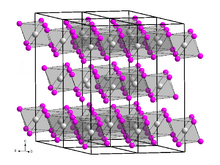Chemistry:Lutetium(III) iodide

| |
| Names | |
|---|---|
| Other names
Lutetium iodide
Lutetium triiodide | |
| Identifiers | |
| ChemSpider | |
| EC Number |
|
PubChem CID
|
|
| Properties | |
| LuI3 | |
| Appearance | solid[1] |
| Density | 5.60 g/cm−3[1][2][3][4] |
| Melting point | 1050 °C[1] |
| Boiling point | 1210 °C[5] |
| Hazards | |
| GHS pictograms | 
|
| GHS Signal word | Warning[1] |
| H315, H335, H319 | |
| P261, P280, P405, P501, P304+340, P305+351+338 | |
Except where otherwise noted, data are given for materials in their standard state (at 25 °C [77 °F], 100 kPa). | |
| Infobox references | |
Lutetium(III) iodide or lutetium iodide is an inorganic compound consisting of iodine and lutetium, with the chemical formula of LuI3.
Preparation
Lutetium(III) iodide can be obtained by reacting lutetium with iodine:[5][2]
- 2 Lu + 3 I2 → LuI3
Lutetium(III) iodide can also obtained by the reacting metallic lutetium with mercury iodide in vacuum at 500 °C:[5]
- 2 Lu + 3 HgI2 → 2 LuI3 + 3 Hg
The elemental mercury generated in the reaction can be removed by distillation.[6]
The lutetium(III) iodide hydrate crystallized from the solution can be heated with ammonium iodide to obtain the anhydrate.[7][5]
Properties
It is a brown, very hygroscopic solid with a bismuth(III) iodide-type crystal structure. In air, it quickly absorbs moisture and forms hydrates.[2][3][4] The corresponding oxide iodide is also readily formed at elevated temperature.[5]
Lutetium(III) iodide doped with cerium is designed for use in PET scanners.[8] Lutetium iodide can be used together with yttrium iodide and gadolinium iodide in LuI3-YI3-GdI3 scintillators to detect neutron and gamma radiation.[9]
References
- ↑ 1.0 1.1 1.2 1.3 1.4 Lutetium(III) iodide, ultra dry, 99.9% (REO) at AlfaAesar, accessed on {{{Datum}}} (PDF) (JavaScript required).
- ↑ 2.0 2.1 2.2 Webelements: Lutetium: lutetium triiodide Retrieved 31.3.2018
- ↑ 3.0 3.1 Americanelements.com: Lutetium Iodide Retrieved 31.3.2018
- ↑ 4.0 4.1 Perry, Dale L. (2016). Handbook of Inorganic Compounds. CRC Press. p. 245. ISBN 9781439814628. https://books.google.com/books?id=SFD30BvPBhoC&pg=PA245. Retrieved 2018-03-31.
- ↑ 5.0 5.1 5.2 5.3 5.4 Georg Brauer (Hrsg.), unter Mitarbeit von Marianne Baudler u. a.: Handbuch der Präparativen Anorganischen Chemie. 3., umgearbeitete Auflage. Band I, Ferdinand Enke, Stuttgart 1975, ISBN 3-432-02328-6, S. 1077.
- ↑ Asprey, L. B.; Keenan, T. K.; Kruse, F. H. Preparation and crystal data for lanthanide and actinide triiodides. Inorg. Chem., 1964. 3 (8): 1137-1240
- ↑ 无机化学丛书 第七卷 钪 稀土元素. 科学出版社. pp 211
- ↑ Saha, Gopal B. (2010) (in en). Basics of PET Imaging: Physics, Chemistry, and Regulations. Springer. p. 23. ISBN 9781441908056. https://books.google.com/books?id=gb6-qYjmL8UC&pg=PA23. Retrieved 2018-03-31.
- ↑ Glodo, Jarek; van Loef, Edgar V. D. & Higgins, William M. (2008-06-17). "Mixed Lutetium Iodide Compounds" (in en). IEEE Transactions on Nuclear Science 55 (3): 1496–1500. doi:10.1109/TNS.2008.922215. ISSN 1558-1578. Bibcode: 2008ITNS...55.1496G.
| HI | He | ||||||||||||||||
| LiI | BeI2 | BI3 | CI4 | NI3 | I2O4, I2O5, I4O9 |
IF, IF3, IF5, IF7 |
Ne | ||||||||||
| NaI | MgI2 | AlI3 | SiI4 | PI3, P2I4 |
S | ICl, ICl3 |
Ar | ||||||||||
| KI | CaI2 | Sc | TiI4 | VI3 | CrI3 | MnI2 | FeI2 | CoI2 | NiI2 | CuI | ZnI2 | Ga2I6 | GeI2, GeI4 |
AsI3 | Se | IBr | Kr |
| RbI | SrI2 | YI3 | ZrI4 | NbI5 | Mo | Tc | Ru | Rh | Pd | AgI | CdI2 | InI3 | SnI4, SnI2 |
SbI3 | TeI4 | I | Xe |
| CsI | BaI2 | HfI4 | TaI5 | W | Re | Os | Ir | Pt | AuI | Hg2I2, HgI2 |
TlI | PbI2 | BiI3 | Po | AtI | Rn | |
| Fr | RaI2 | Rf | Db | Sg | Bh | Hs | Mt | Ds | Rg | Cn | Nh | Fl | Mc | Lv | Ts | Og | |
| ↓ | |||||||||||||||||
| La | Ce | Pr | Nd | Pm | SmI2 | Eu | Gd | TbI3 | Dy | Ho | Er | Tm | Yb | Lu | |||
| Ac | ThI4 | Pa | UI3, UI4 |
Np | Pu | Am | Cm | Bk | Cf | EsI3 | Fm | Md | No | Lr | |||
 |

